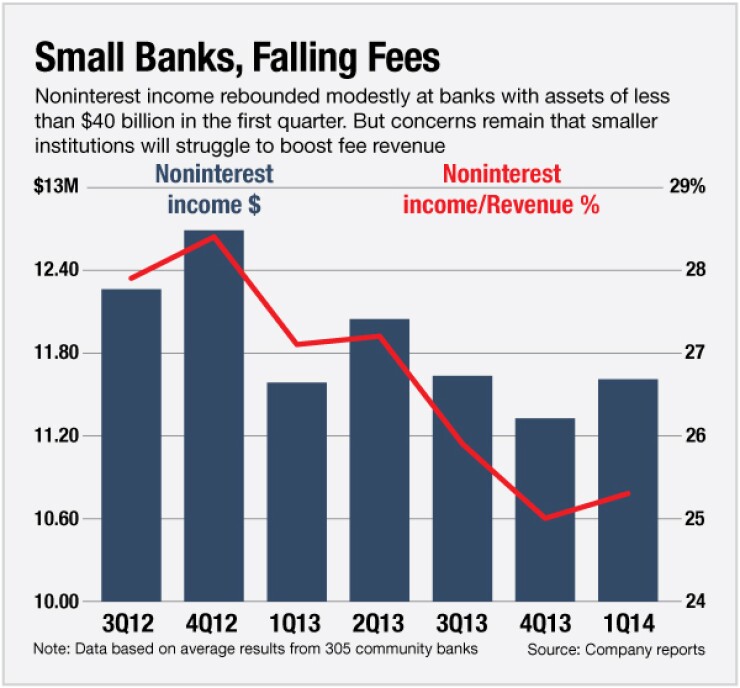-
With help from their vendors, small banks are enhancing their online and mobile banking offerings by adding features that allow business clients to more quickly approve wire transfers, send out invoices and manage other day-to-day tasks that previously may have required a visit to the branch.
April 28 -
Midsize banks remain concerned about their ability to meaningfully grow revenue at a time when yields on loans are narrowing and income from mortgage banking a key revenue driver continues to shrink.
April 17 -
The qualified-mortgage rule, reduced refi activity and ongoing commoditization are forcing smaller institutions to take a hard look at exiting the mortgage origination business.
January 9

Community banks shouldn't count on fee income to boost earnings this year.
The
"Overall, the first quarter's results were uninspiring," says Jeff Davis, managing director of the financial institutions group at Mercer Capital. "I contend that bank earnings are not as strong as Wall Street thinks they are. A year ago, earnings were masked by the outsized strength of mortgages."
Noninterest income, which has been under pressure for several quarters, was relatively flat in the first quarter compared to a year earlier, according to American Banker analysis of quarterly results from more than 300 banks with less than $40 billion in assets.
Service charges have also been a challenge for banks, says Jim Adkins, a managing member at Artisan Advisors. Such charges were largely unchanged from a year earlier, according to the American Banker data. Regulation, changing consumer behavior and banks altering checking account policies account for some of the drop in service charges, industry experts say.
"Banks are continually going to have issues with service charges as people bank differently," Adkins says. "That is income that will be hard to replace."
Noninterest income also took a hit in the first quarter from lower transaction volumes due, in part, to the unusually harsh weather, says Ken Zerbe, an analyst at Morgan Stanley.
Inclement weather cut into services charges at F.N.B. Corp. (FNB) in Hermitage, Pa., Vincent Delie Jr., the $14.5 billion-asset company's president and chief executive, said during a quarterly conference call earlier this month. Such charges fell nearly 8% at F.N.B. from a year earlier.
"Across our footprint, particularly in Maryland and western Pennsylvania, the weather was pretty severe," Delie told analysts. "There was one day where we had nearly 30 branches closed for one full day. I don't know if that's ever happened in my career. It was pretty severe."
Gains on loan sales also continued to decline, Adkins says. A surge in refinancing had
"We have the perfect storm against a healthy mortgage market," Adkins says. "You have low job participation, higher interest rates and then, on top of that, the
Umpqua Holdings (UMPQ) in Portland, Ore., reported lower quarterly earnings due in part to "an expected softening of the mortgage market," Ray Davis, the $22 billion-asset company's president and chief executive, said during a conference call this month. Mortgage banking revenue fell 56% from a year earlier, to $10.4 million. Management was "quick to reduce companywide operating expense for the quarter," he said.
Still, Umpqua's management said they expect some rebound in mortgage activity in the second quarter. The company also expects its recent purchase of Sterling Financial to further boost fee income.
Banks could turn more to acquisitions to increase fee income, Jeff Davis says. Otherwise, banks should complete a strategic review of their services and fees to see where they can improve, says Lynn David, president of Community Bank Consulting Services. This means evaluating more than just how overdraft fees compare to those of competitors.
Banks should consider how they can provide value-added products, while also considering "realistic" pricing for such services, David says. "We are at the point where banks have to look at everything."
Small-business customers are an area where smaller banks can improve, says Trent Fleming at Trent Fleming Consulting. Community banks are looking to offer a variety of products to small businesses, such as remote deposit capture. Research shows that
"When we talk about new products and services, there needs to be a demonstrated value and need to charge for it," Fleming says. A service like commercial remote-deposit capture can "improve cash flow for a small business" and ensure that payments make it to a customer's account in a timely manner.
Still, "there is no magic bullet" for community banks that need to replace fee income, Jeff Davis warns.
Paul Davis contributed to this story.





